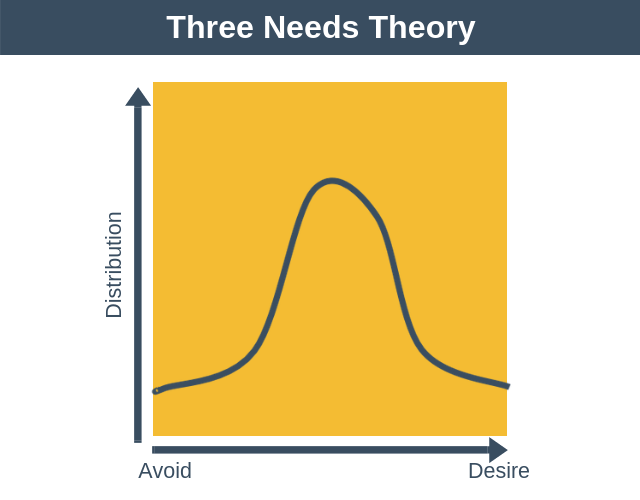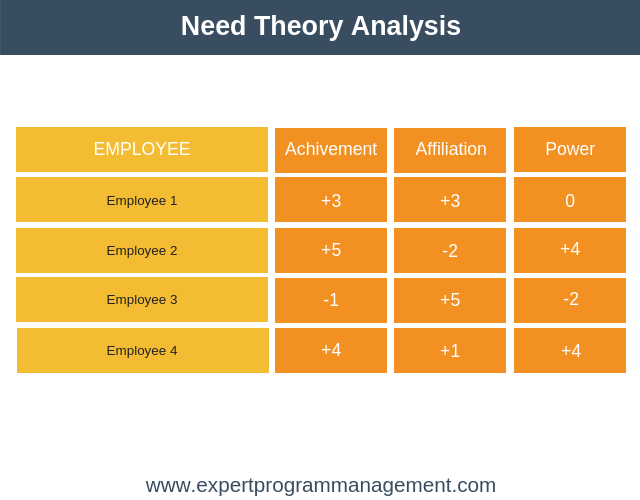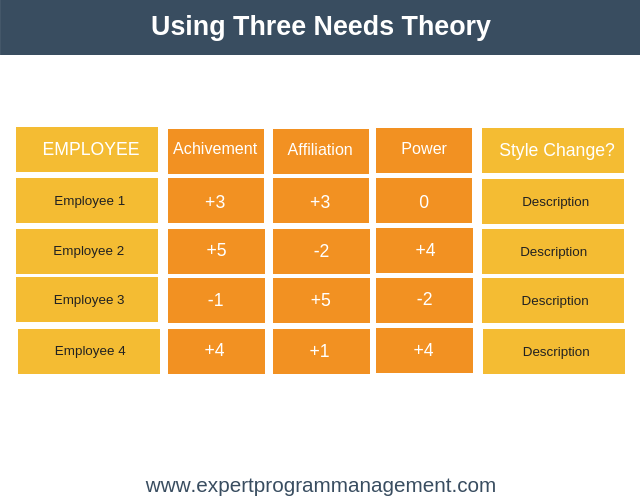according to mcclelland, what is the need for achievement based on?
McClelland's Need Theory of Motivation (Three Needs Theory) provides a mode for managers to determine the factors motivating each of their team members. Managers and squad leaders can employ this information to collaborate with each team member in ways most probable to motivate them.
Why Is It Useful?
Permit's imagine that you are a director giving a team member their annual functioning appraisal.
This team fellow member has performed exceptionally well this yr, so yous'd like to advantage them by allowing them to take the lead on a high-take a chance project with potentially great upside for the organisation, and also for them. This new projection will be their advantage for performing then well the previous year.
However, upon hearing they've been given the project they don't seem at all positive. Why? Well, one reason is that you may take misread their motives.
While they might want to reach dandy things in their career, perhaps they don't want to take on a high-adventure project for fearfulness it could damage their career prospects should they fail.
Another reason might be that they prefer existence role of a great team and don't like taking center phase.
In this example, using Three Needs Theory would have been useful. With it you could take understood the motivations of your team fellow member in accelerate of the appraisal, so y'all could have rewarded them in a manner that would motivate them.
Note
The Need Theory of Motivation also goes by a number of other names including:
- Three Needs Theory.
- Demand Theory.
- Learned Needs Theory.
- McClelland'due south Theory of Needs.
- Motivational Needs Theory.
Need Theory of Motivation
Three Needs Theory was developed by David McClelland in his 1961 book, The Achieving Society. The three needs that he identified were a need for accomplishment, a demand for amalgamation, and a need for power.
McClelland states that we all accept these three needs in some form or some other regardless of age, gender, race, or cultural origin. Each individual'south needs are learned through their life experiences and are not innate at birth. This is why the theory is also sometimes chosen Learned Needs Theory.
Need Theory of Motivation built on Abraham Maslow's Bureaucracy of Needs, developed some 20 years earlier in the 1940s.
The Three Needs
Let's examine each of the 3 needs in plow. Before we practise, it is worth noting that each of these needs exists on a sliding calibration.

For example, while some people may desire power, not everyone wants to be powerful at all costs. Similarly, while some people avoid the spotlight at all costs, nearly people savour a little praise. Most people don't exist at the extremes of each need. This is represented by the bong curve shape in the above diagram.
In a nutshell, each individual will be motivated to a greater or lesser extent by each of the motivating factors.
1. Need for Achievement
Someone with a need for achievement would:
- Be motivated by accomplishment and the opportunity for promotion.
- Have a potent want to complete complex tasks, set up records, or practice something not done earlier.
- Prefer it when results are under their control and based on their effort rather than external factors.
- Similar to receive regular feedback.
- Avoid high-risk and low-chance situations. Low-risk situations offer no sense of achievement, and high-risk situations are too much outside of their control.
Team members with very low achievement needs tend to avoid situations where they tin can fail. Conversely, people with too high an achievement need will want to win at any cost and will want to receive all of the praise.
2. Demand for Affiliation
Someone with a demand for affiliation would:
- Exist motivated by achieving and retaining acceptance as part of a group. They like to be liked.
- Follow the social norms of an organization for fright of rejection.
- Enjoy collaboration but dislike competitive situations.
- Avert high-take a chance and low-risk situations.
Team members with very low affiliation needs tend to be loners, often introverts, with little desire to socialize at piece of work. Conversely, people with too high an affiliation need will demand blind loyalty, and be intolerant of any disagreement.
3. Need for Power
Someone with a need for power would:
- Want to be in charge of others.
- Bask winning and contest.
- Place a high-value on discipline.
- Enjoy having condition and motivating others.
Team members with very depression power needs tend to be subordinate and dependent. Conversely, people with very loftier ability needs can be rude, exaggerate their own abilities, and want to control everything.
Using the Three Needs Theory
Three Needs Theory can assist you identify the primal motivators driving each member of your squad.
You lot tin can and so use this information to help yous get the about out of each team member. You can practice this by irresolute the mode you lot give feedback, set goals, accommodate your leadership style, and the approach by which you try and motivate them.
Information technology'south important to realize that when we modify our approaches to all-time suit each squad member, we are not trying to coerce them in whatsoever way. Rather, we are trying to create win-win situations. This ways that your team member'south needs are being fulfilled (they win), and as a outcome, they are motivated to exercise their best to evangelize (you win).
There are just two steps to perform to employ Needs Theory:
1. Make up one's mind Needs
You can apply a tabular array similar to the following i to understand the needs of each team member. For each entry in the table, score each team member from -5 to +5. Were +5 indicates a very potent need and -5 a very strong aversion.

To consummate this table you can call up about the actions and behavior of your team members in the past. Exercise this by asking yourself some questions. For instance:
- Do they seek praise?
- Do they button to achieve deadlines?
- Do they like to be in charge?
- Are they introverted or extroverted?
- Do they enjoy being role of a team?
If you're new to your task or just simply don't know your squad that well you could become them to score themselves for each of the three needs.
two. Determine How You Volition Adapt your Way
All that now remains to exist done is to determine how you volition conform your fashion and approach with each team member. The 3 Needs Theory diagram below has been updated to reflect this change.

You can then use this table as a reminder as to how to approach each member of your squad. Remember to update the tabular array from time to time as new insights nigh your squad members come up to lite.
Summary
Need Theory of Motivation provides a mechanism for team leaders and managers to understand what motivates each of their team members.
One time armed with this information, managers tin adjust how they interact with each squad member to ensure they are getting the most out of them. Using Three Needs Theory to create motivated squad members creates a win-win for both the team fellow member and the director.
Demand Theory of Motivation isn't the only theory out there we can utilize to endeavour and motivate our team. In that location are many others in existence. You tin can learn well-nigh these in our Team Direction section.
Source: https://expertprogrammanagement.com/2018/10/need-theory-of-motivation/
0 Response to "according to mcclelland, what is the need for achievement based on?"
Post a Comment